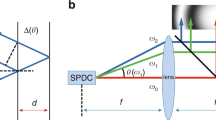Abstract
IN a recent paper1, we have shown that the infrared frequencies of glass can be calculated by taking the wave-lengths of the maxima of absorption bands of didymium glass as the incident exciting radiations, and those of the maxima of the fluorescent bands of the same glass excited by sunlight, as the Raman lines. The values thus obtained are in excellent agreement with those obtained for glass by the usual method of experimentation using a mercury lamp and many hours of exposure.
This is a preview of subscription content, access via your institution
Access options
Subscribe to this journal
Receive 51 print issues and online access
$199.00 per year
only $3.90 per issue
Buy this article
- Purchase on Springer Link
- Instant access to full article PDF
Prices may be subject to local taxes which are calculated during checkout
Similar content being viewed by others
References
Z. Phys., 98, 324 (1935).
Trans. Chem. Soc., 99, 637 (1911).
” Molecular Spectra and Molecular Structure”, Faraday Soc. Disc. No. 790, pp. 860–63 (1929).
Author information
Authors and Affiliations
Rights and permissions
About this article
Cite this article
PROSAD, K., BHATTACHARYA, D. Excitation of Raman Spectra of Substances with the aid of Optical Catalysers. Nature 138, 510–511 (1936). https://doi.org/10.1038/138510a0
Issue Date:
DOI: https://doi.org/10.1038/138510a0
This article is cited by
Comments
By submitting a comment you agree to abide by our Terms and Community Guidelines. If you find something abusive or that does not comply with our terms or guidelines please flag it as inappropriate.



